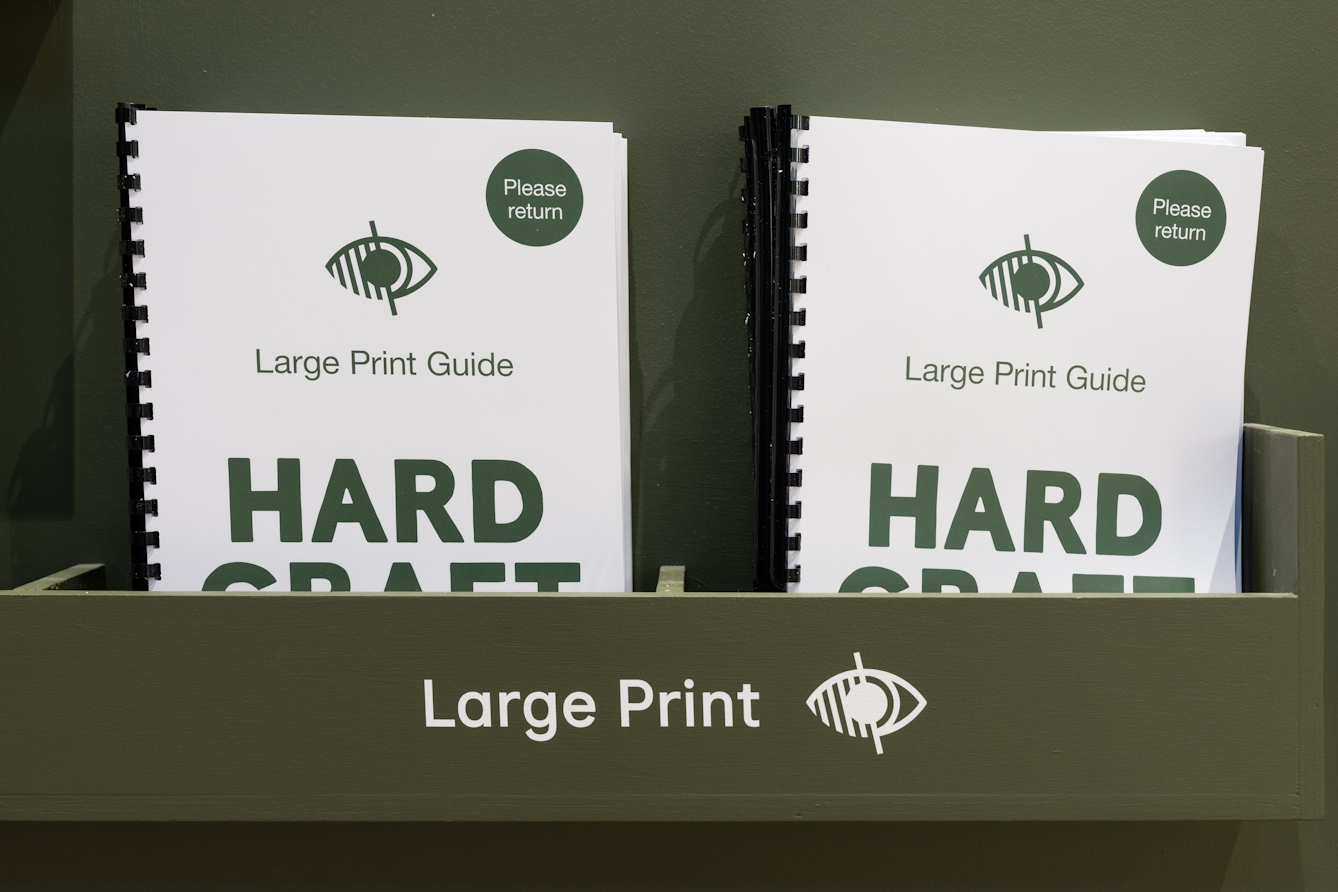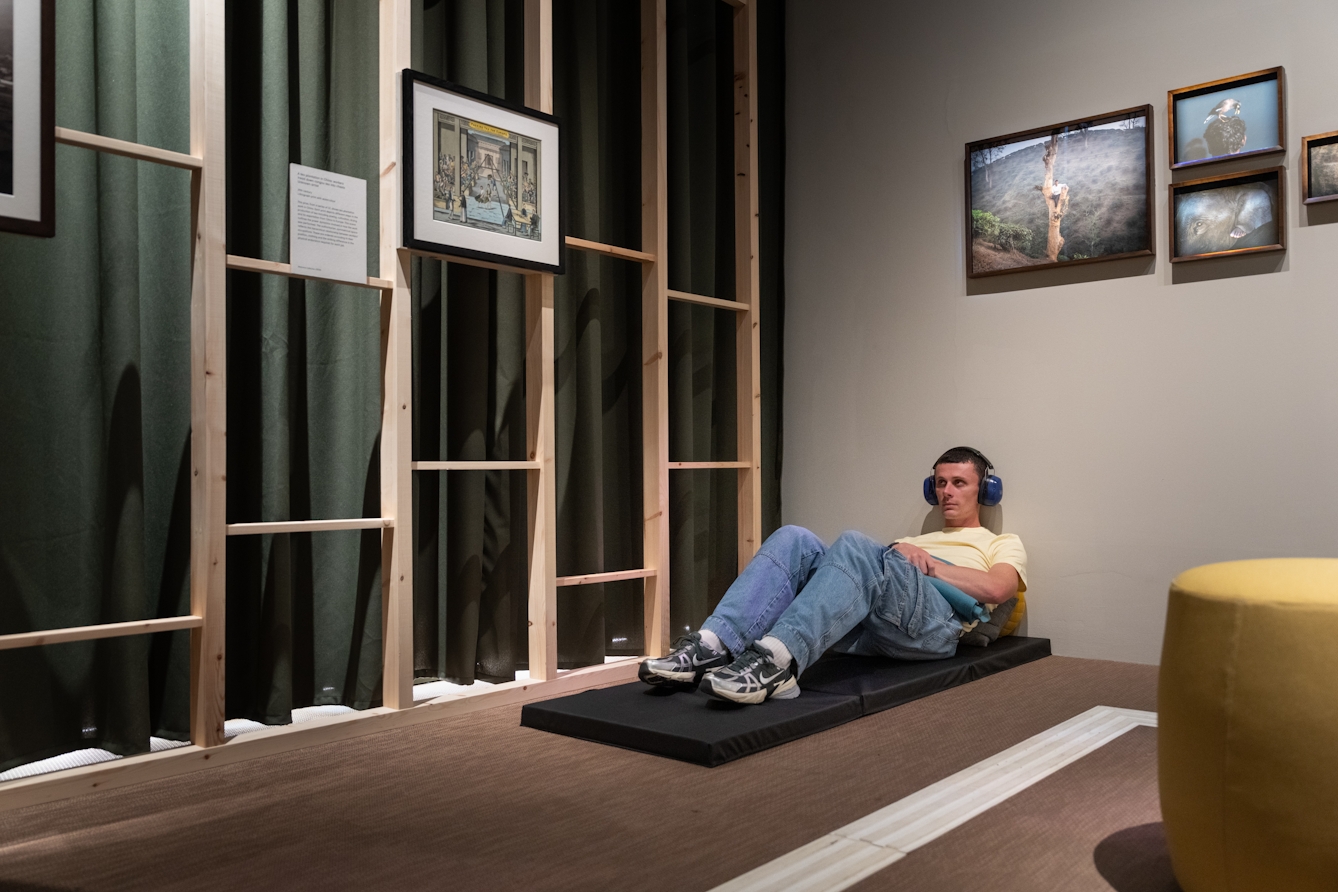Information to help you plan and prepare for your visit to the exhibition.
Hard Graft: Work, Health and Rights visual story
Video visual story
Easy-read visual story
Introduction to Hard Graft: Work, Health and Rights

This exhibition is called ‘Hard Graft: Work, Health and Rights’.
An exhibition is a collection of things to look at and learn about.

The exhibition is at Wellcome Collection.

The exhibition is in Gallery 1 on level 0 of our building.
Visiting Wellcome Collection
For more information about:
- opening times
- accessibility
- travel
click on this link: Visiting Wellcome Collection visual story.
About the exhibition

‘Hard Graft: Work, Health and Rights’ is an exhibition about different kinds of work, and how work can affect our health. It tells stories about:
- People who do the kind of work that we often do not notice or care about. For example, cleaners.
- How some kinds of work can be unsafe or harmful for the people who do them.
- How workers join together and take action to make these kinds of work safer.
- The things people do to heal from this kind of work. Healing means to get better.

The exhibition is in Gallery 1 on level 0.
What is in the exhibition
There are different things to look at and listen to in the exhibition. These include:

- objects
- books
- photographs
- paintings and drawings
- sculptures.

- films

- sound works.

If you need any help, you can speak to a member of our team.
Sensory information

People sometimes speak quietly at an exhibition. But you do not have to speak quietly.
The lights are not very bright in the exhibition.
What is in the introduction

The first room is the introduction to the exhibition.
‘Gestures of Labour’ is a short film showing people doing different kinds of work with their hands. The film was made in Jakarta in Indonesia. Indonesia is in Southeast Asia.
The film lasts about 5 minutes and has no sound.
What is in section 1

Section 1 is called ‘The Plantation’.
A plantation is a big area of land where things are grown, like:
- coffee
- tea
- cotton.
Working on plantations is very hard. Some workers are exploited. Exploited means people don’t get paid for their work, or are paid very little.
Work on plantations still happens around the world today. Working on a plantation badly harms the workers’ health.

‘Dark Garden’ is a group of photographs of tea plantations in Bangladesh and some of the people who work on them.
The people in these photographs get paid around £1 a day for their work.

‘Works by Charmaine Watkiss’ are drawings and a sculpture of women whose ancestors were born in Africa. An ancestor is a person in your family who lived in the past – like a great-grandparent.
These works show plants and fruits that help to heal people when they are ill.

‘Mosquito Shrine’ is a work about:
- How humans affect where mosquitoes live. Mosquitoes are tiny flying insects. Mosquitoes travelled to Brazil on ships that carried enslaved people from Africa.
- How mosquitoes affect human health. Mosquitoes bite humans. These bites can spread diseases in humans. One disease spread by mosquitoes is yellow fever.
What is in section 2

Section 2 is called ‘The Street’. It tells stories about:
- people who work in the streets
- how working in the streets can be unsafe, and harmful to your health
- how street workers are joining together and taking action to get better working conditions.

‘Sweeping’ is a work about people who clean the streets in Sharjah, a city in the United Arab Emirates. The United Arab Emirates is a country in Western Asia.
The artist, Vikram Divecha, worked with 5 street sweepers to make an artwork using bags of rubbish that they had collected.
People often don’t notice the work of street sweepers. The artist wanted to show how important and beautiful their work is.

‘Money Makes the World Go Round’ is about the stories and histories of sex workers. Sex workers are people who get paid for sex.
The artist is called Lindsey Mendick. Lindsey worked with a group of sex workers in the UK when she was planning her installation.
What is in section 3

Section 3 is called ‘The Home’. It tells stories about how:
- different kinds of work are done in the home
- doing this kind of work can be harmful
- a lot of this work is hidden because it happens inside people’s homes, not in public
- people doing this kind of work are often badly paid, or not paid at all.

‘Washerwoman’ is a sculpture made by Shannon Alonzo. She created it in her grandmother’s house in Trinidad.
Trinidad is an island in the Caribbean. The Caribbean is made up of:
- a group of islands in the Caribbean Sea and the Atlantic
- some places in North America and South America that are next to the Caribbean Sea.
The sculpture is about the work that washerwomen did in the Caribbean in the past. It is about the effect of this kind of work on the women’s bodies.

‘No Rest for the Wicked’ is a group of photographs about women in the artist’s family. Her great-grandma, grandma and mum all worked as cleaners. The artist also worked as a cleaner.
The photos show how cleaning can be tiring and hard on the body.

‘Care Chains (Love Will Continue to Resonate)’ is an installation about domestic workers. Domestic workers do different kinds of work in people’s homes, like:
- cooking
- cleaning
- looking after children.
The artist, Moi Tran, made this with migrant domestic workers in England. Migrants are people who move from one country to another, often to find work.
To create this installation, Moi worked with:
- musicians
- a body percussionist. Body percussion is when you use your body to create sounds, like clapping
- a choreographer. Choreographers create dance routines
- a composer. Composers create sound and music.
Accessibility in the exhibition

You can find accessible guides at the start of the exhibition.
The guides are:

- A gallery guide with words and pictures.

- A large-print guide.

- A visual story.

- A sensory map. A sensory map shows you where there are things like out-loud sound, bright lights, or seating.
Digital guides

There are 12 stops in the digital guides.
There is a number and a QR code next to each stop in the exhibition. You can scan the QR codes with your phone to get the digital guides.
To scan a QR code:
1) open the camera on your phone
2) point it at the QR code
3) click on the link that appears.
If you do not know how to scan a QR code, we can help you.

There is a white line on the exhibition floor. Follow the white line to get to each stop.
The white line has a pattern that you can feel with your feet.

Or you can listen to the audio-descriptive guide by:
1) picking up a touch-button handset in the exhibition
2) pressing the number of the audio stop.
You can get all the information that is on the exhibition labels and panels by scanning the QR code with your phone. The information can be read by a screen reader.
To scan a QR code:
1) open the camera on your phone
2) point it at the QR code
3) click on the link for ‘Exhibition text’.
If you do not know how to scan a QR code, we can help you.

If you need help with anything, you can ask a member of our gallery team.
Relaxed openings

If you need additional support to enjoy this exhibition, join us for a relaxed opening. At a relaxed opening there will be:
- fewer visitors
- extra gallery staff to help you.

At a relaxed opening you can use our:
- cushions
- ear defenders
- tinted glasses
- tinted visors
- weighted lap pads.
At a relaxed opening there will be a chill-out room. The chill-out room has:
- low lighting
- soft seats
- sensory and fidget toys.









